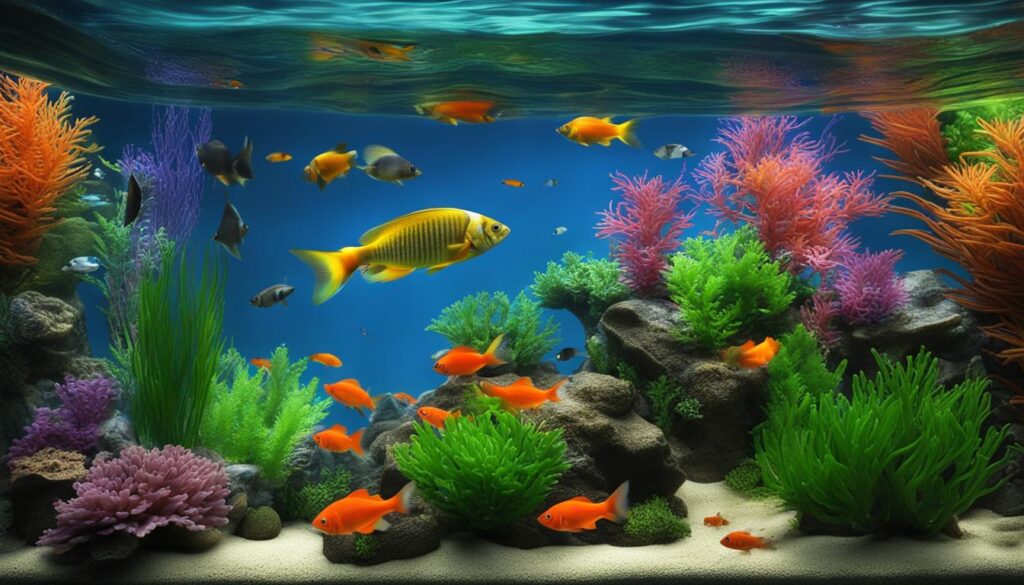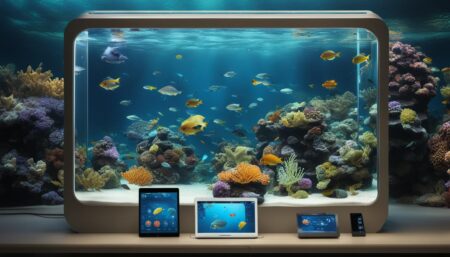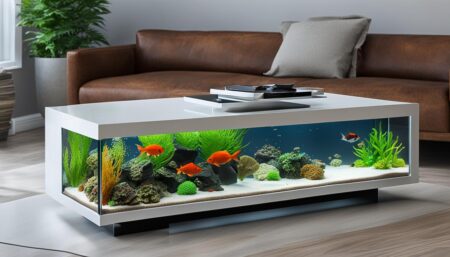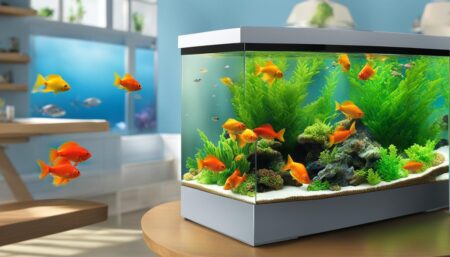Welcome to our complete guide to aquarium automated fish feeding! In this article, we will explore the fascinating world of fish feeding systems, with a special focus on automatic fish feeders. These ingenious devices have revolutionized the way we care for our aquatic pets, providing convenience and efficiency like never before.
Imagine having the ability to effortlessly maintain a consistent feeding schedule for your fish, without the hassle of manual feeding. With an automatic fish feeder, this becomes a reality. Whether you are a busy individual who is frequently away from home or simply want to ensure that your fish receive the proper nutrition at precise intervals, an automated fish feeder is the ideal solution.
Key Takeaways:
- An automated fish feeder offers convenience and efficiency in maintaining a consistent feeding schedule for your aquarium.
- It reduces the risk of overfeeding and ensures that your fish receive the proper nutrition at the right times.
- There are various types of automated fish feeders available, including smart fish feeders, programmable feeders, and automatic feeding devices.
- When choosing an automated fish feeder, consider factors such as aquarium size, fish feeding requirements, and ease of use and maintenance.
- Regular maintenance and troubleshooting are essential to ensure the proper functioning of an automated fish feeder.
Benefits of Using an Automated Fish Feeder
Using an automated fish feeder offers several benefits for aquarium owners. It allows for precise and consistent feeding schedules, ensuring that your fish receive the proper nutrition at the right times. It also reduces the risk of overfeeding, which can lead to poor water quality and health issues for the fish. Additionally, an automated fish feeder can be programmed to feed fish when you are not available, making it a convenient solution for busy individuals.
Benefits of Using an Automated Fish Feeder
- Precise and consistent feeding schedules
- Reduced risk of overfeeding
- Convenient solution for busy individuals
An automated fish feeder allows you to set up a feeding schedule that ensures your fish are consistently fed at the same times each day. This helps maintain a routine for your fish and ensures they receive the necessary nutrients regularly. By eliminating the need for manual feeding, an automated fish feeder also reduces the risk of overfeeding, which can lead to health problems and deteriorated water quality in the aquarium.
One of the key advantages of using an automated fish feeder is the convenience it offers. Whether you are going on vacation or simply have a busy schedule, you can program the feeder to dispense food while you are away. This ensures that your fish are still being fed even if you are not able to do so personally. The ability to automate the feeding process provides peace of mind for aquarium owners and helps maintain the well-being of the fish.
| Benefits of Using an Automated Fish Feeder |
|---|
| Precise and consistent feeding schedules |
| Reduced risk of overfeeding |
| Convenient solution for busy individuals |
Overall, using an automated fish feeder can greatly simplify and enhance the fish feeding process. It provides precise feeding schedules, reduces the risk of overfeeding, and offers convenience for busy aquarium owners. With the various options available on the market, you can choose an automated fish feeder that best suits your needs and ensures the health and well-being of your fish.
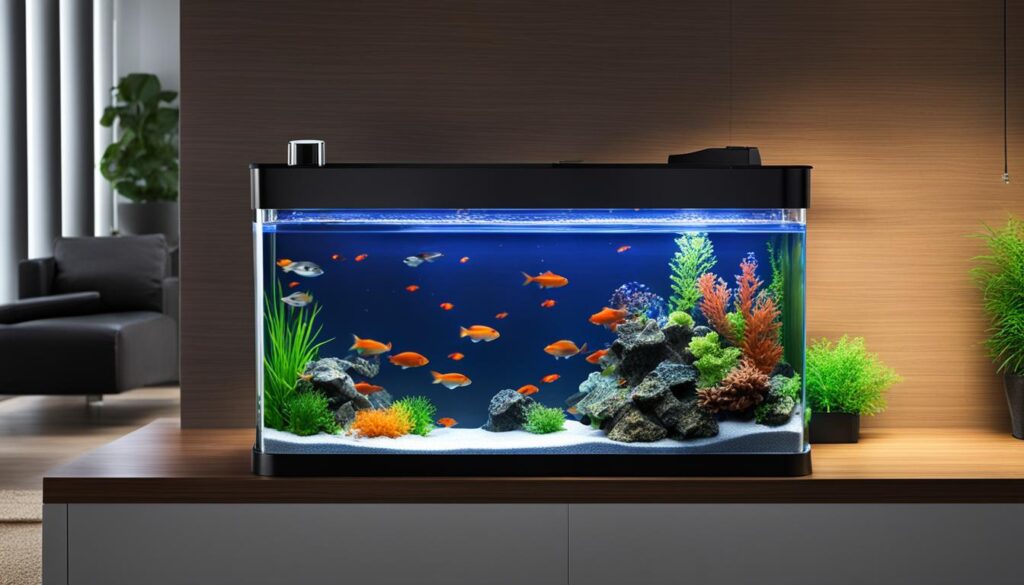
Types of Automated Fish Feeders
When it comes to automated fish feeders, there are various types available to suit different aquarium setups and feeding preferences. These feeders offer a convenient and efficient way to ensure your fish are fed properly, even when you’re not available. Let’s explore the different types of automated fish feeders:
Smart Fish Feeders
Smart fish feeders are a modern and innovative option for aquarium owners. These feeders can be controlled remotely through a companion app, allowing you to schedule feedings and monitor them from anywhere. With smart fish feeders, you have the flexibility to adjust feeding schedules based on your fish’s specific needs and easily make changes as needed. They often come with additional features such as adjustable portion sizes and notifications to keep you updated on feeding activities.
Programmable Fish Feeders
Programmable fish feeders are another popular choice among aquarium enthusiasts. These feeders can be set to dispense food at specific times and quantities, giving you control over your fish’s feeding schedule. Programmable fish feeders offer flexibility, allowing you to tailor the feeding routine to match your fish’s natural feeding habits. They are easy to use and often come with LCD screens or digital interfaces for convenient programming.
Automatic Feeding Devices
Automatic feeding devices are designed to attach to the aquarium and release food into the tank at regular intervals. These devices typically use gravity or timers to dispense the fish food. Automatic feeding devices are a reliable and straightforward option for maintaining consistent feeding schedules. They are often easy to install and require minimal programming, making them suitable for beginners or those who prefer a simple feeding solution.
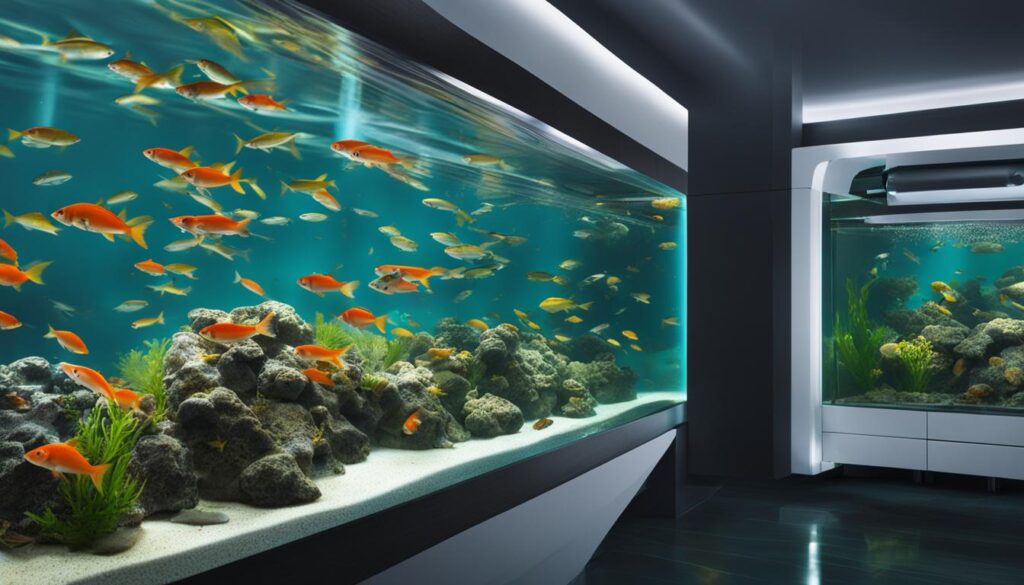
It’s important to choose the right type of automated fish feeder based on your specific needs and the requirements of your fish. Consider factors such as the size of your aquarium, the types of fish you have, and your desired level of control over the feeding schedule. By selecting the most suitable automated fish feeder, you can ensure that your fish receive the proper nutrition and care they need for a healthy and thriving aquarium.
Factors to Consider When Choosing an Automated Fish Feeder
When selecting an automated fish feeder, there are several important factors to consider. These factors will ensure that you choose a feeder that is compatible with your aquarium setup and meets the specific needs of your fish.
Aquarium Size: The size of your aquarium will determine the size and capacity of the automated fish feeder you need. A larger aquarium may require a feeder with a larger food hopper to hold enough food for all the fish.
Fish Species: Different fish species have different feeding requirements. Some fish may require smaller, more frequent feedings, while others may need larger portions less often. It is crucial to choose a feeder that can accommodate the specific feeding needs of your fish.
Feeding Schedule: Consider how often and at what times you want the automated fish feeder to dispense food. Some feeders offer customizable feeding schedules, allowing you to program specific feeding times and quantities. This feature can be beneficial if you want to simulate natural feeding patterns or if you have fish with specific dietary needs.
| Factor | Description |
|---|---|
| Aquarium Size | The size of your aquarium will determine the size and capacity of the automated fish feeder you need. A larger aquarium may require a feeder with a larger food hopper to hold enough food for all the fish. |
| Fish Species | Different fish species have different feeding requirements. Some fish may require smaller, more frequent feedings, while others may need larger portions less often. |
| Feeding Schedule | Consider how often and at what times you want the automated fish feeder to dispense food. Some feeders offer customizable feeding schedules, allowing you to program specific feeding times and quantities. |
| Ease of Use and Maintenance | Choose a feeder that is easy to use and maintain. Look for features such as easy-to-read displays, intuitive controls, and removable food hoppers for easy cleaning and refilling. |
Ease of Use and Maintenance: Choosing a feeder that is easy to use and maintain is essential for ensuring its longevity and proper functioning. Look for features such as easy-to-read displays, intuitive controls, and removable food hoppers for easy cleaning and refilling.
By considering these factors, you can select an automated fish feeder that is suitable for your aquarium setup and provides the necessary care for your fish. Remember to thoroughly research different brands and models, read reviews, and consult with knowledgeable aquarium professionals to make an informed decision.
Installation and Setup of an Automated Fish Feeder
Installing and setting up an automated fish feeder is a straightforward process that can be done by following the manufacturer’s instructions. Here are the general steps to help you get started:
- Choose a suitable location for the feeder: Place the automated fish feeder near the aquarium, ensuring it is securely attached or mounted to prevent accidental falling.
- Program the feeding schedule: Most automated fish feeders allow you to set specific feeding times and quantities. Use the control panel or companion app to input the desired schedule and portion sizes. This ensures that your fish are fed at regular intervals and receive the appropriate amount of food.
- Fill the feeder with food: Depending on the type of feeder, you may need to fill the hopper or compartment with the appropriate type and amount of fish food. Be sure to use fish food that is suitable for your fish species and consider any dietary requirements or restrictions.
- Test the feeder: Before leaving it unattended, perform a test run to ensure that the automated fish feeder is dispensing the food correctly. Monitor the feeding process and make any necessary adjustments to the feeding schedule or portion sizes.
Remember to refer to the manufacturer’s instructions for any specific installation and setup guidelines for your particular model of automated fish feeder. Following these steps will help ensure a smooth and successful installation, allowing you to enjoy the convenience of automated fish feeding.
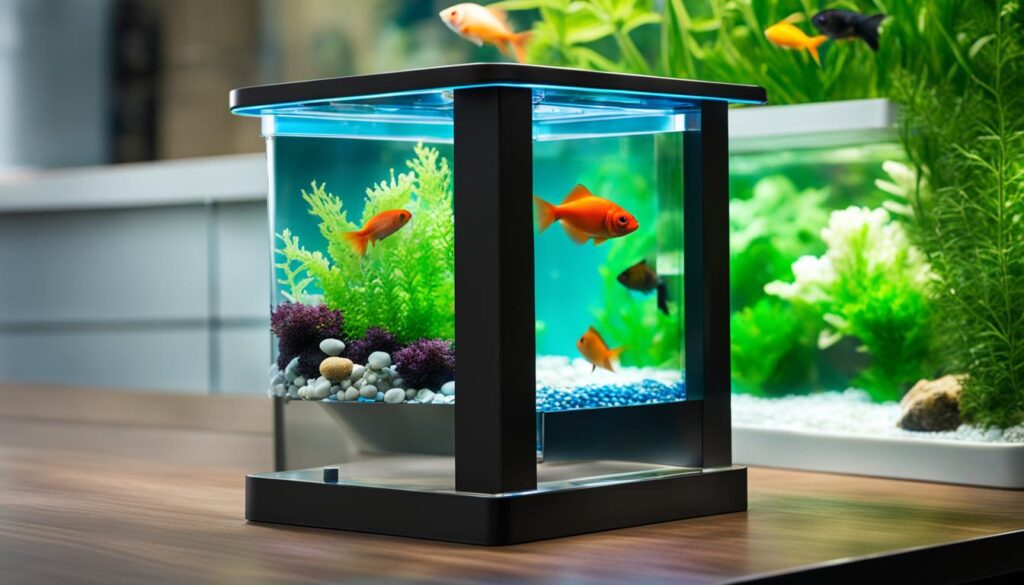
Table 5: Comparison of Popular Automated Fish Feeders
| Brand | Features | Price Range | Rating |
|---|---|---|---|
| EHEIM | Programmable, reliable, multiple feeding times, portion control | $50 – $100 | 4.5/5 |
| Rusee | Affordable, easy-to-use, adjustable feeding quantities | $20 – $50 | 4/5 |
| Tetra | Simple design, battery-powered, easy installation | $15 – $30 | 3.5/5 |
“Having an automated fish feeder has made my life so much easier. I no longer have to worry about remembering to feed my fish or finding someone to do it when I’m away. It’s a game-changer!” – Sarah, aquarium enthusiast
Maintenance and Troubleshooting of an Automated Fish Feeder
Regular maintenance is essential to ensure the proper functioning of an automated fish feeder. By following a few simple steps, you can keep your fish feeding system in optimal condition. Here are some maintenance tips to keep in mind:
Cleaning the Feeder
Regularly clean the feeder to remove any leftover food or debris. Use a soft brush or cloth to gently scrub the feeder, avoiding harsh chemicals that may be harmful to your fish. Rinse thoroughly before refilling with food to prevent contamination.
Battery Check
Check the batteries in your automatic fish feeder regularly to ensure they are functioning properly. Replace old or weak batteries to avoid interruptions in feeding schedules. It is also a good idea to keep spare batteries on hand for emergencies.
Food Level Monitoring
Monitor the food levels in your feeder to ensure that it does not run out of food. Adjust the feeding amounts and frequency as needed to suit the needs of your fish. Regularly check for any clogs or issues that may prevent the food from dispensing properly.
If you encounter any issues with your automated fish feeder, such as food dispensing problems or malfunctioning, refer to the manufacturer’s troubleshooting guide or contact their customer support for assistance. They can provide guidance and help you resolve any issues you may be experiencing.
| Issue | Solution |
|---|---|
| Food not dispensing | Check for clogs or blockages in the dispenser tube. Clean if necessary. Ensure that the feeder is properly assembled and programmed with the correct feeding schedule. |
| Feeder not turning on | Check the batteries and ensure they are correctly inserted. Replace the batteries if necessary. If the issue persists, contact customer support for further assistance. |
| Erratic feeding schedule | Double-check the programming of your feeder to ensure that the correct feeding times and amounts are set. Reset the feeder if needed and reprogram with the desired schedule. |
By properly maintaining and troubleshooting your automated fish feeder, you can ensure that your fish receive their meals on time and in the right quantities. With regular care and attention, you can enjoy the convenience and benefits of an automated feeding system for your aquarium.
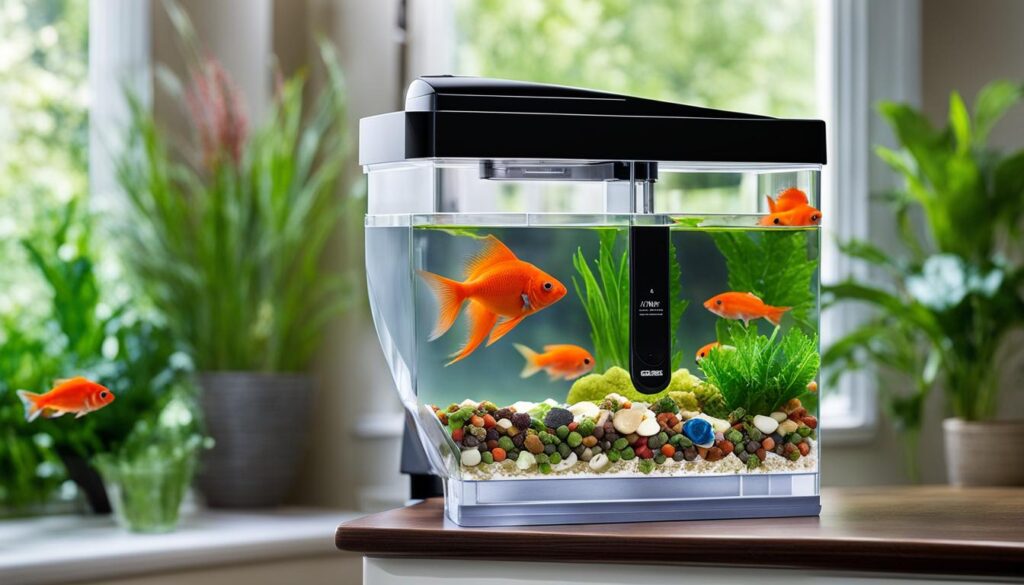
Popular Brands of Automated Fish Feeders
When it comes to automated fish feeders, there are several popular brands that offer reliable and innovative solutions for aquarium owners. These brands have established themselves as leaders in the industry, providing a wide range of options to meet the diverse needs of fish enthusiasts. Let’s take a closer look at some of the most renowned brands in the market.
EHEIM
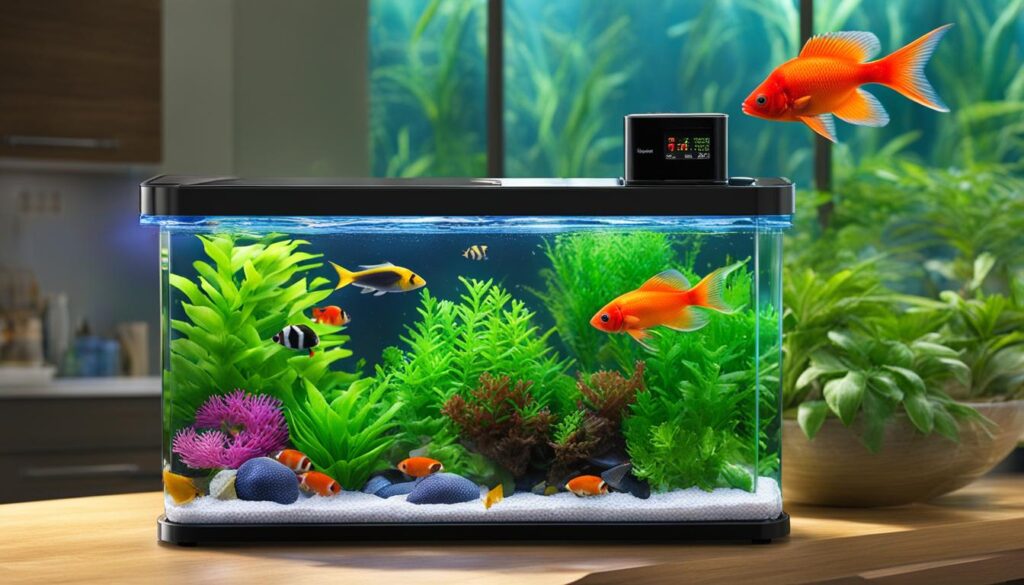
EHEIM is a well-known brand that specializes in high-quality automated fish feeders. Their feeders are known for their reliability and programmable features, allowing users to set precise feeding schedules for their fish. With EHEIM feeders, aquarium owners can have peace of mind knowing that their fish are consistently receiving the right amount of food at the right time.
Rusee
Rusee is another popular brand in the automated fish feeder market, offering affordable and user-friendly options. Rusee feeders are known for their simplicity and ease of use, making them a great choice for beginners or those on a budget. Despite their affordability, Rusee feeders still provide reliable feeding mechanisms to ensure that fish receive their meals on time.
Other Notable Brands
In addition to EHEIM and Rusee, there are several other reputable brands worth mentioning. Some of these include:
- Tetra: Known for their extensive range of fish care products, Tetra also offers automated fish feeders that are designed to provide optimal nutrition for aquarium fish.
- Fluval: As a trusted name in the aquarium industry, Fluval offers automated fish feeders that are built with advanced technology and customizable feeding options.
- Juwel: Juwel is known for their high-quality aquarium equipment, and their automated fish feeders are no exception. Their feeders are designed to seamlessly integrate with Juwel aquariums.
Before making a decision, it’s important to research and read reviews to find the best brand and model that suits your specific requirements. Each brand has its own unique features and advantages, so take the time to compare and choose the automated fish feeder that will best meet the needs of your aquarium and fish.
DIY Automated Fish Feeder Projects
For aquarium enthusiasts who enjoy do-it-yourself projects, creating your own automated fish feeder can be a rewarding and cost-effective option. By using readily available components such as microcontrollers, servos, and 3D-printed parts, you can design a custom feeder that meets your specific needs.
There are various online resources that provide detailed instructions and schematics for building DIY automated fish feeders. These resources offer step-by-step guidance on assembling the feeder, programming it to dispense the desired amount of food at scheduled times, and ensuring its compatibility with your aquarium setup.
Before attempting a DIY project, it is important to have basic technical skills and knowledge. Familiarize yourself with the components and their functions, and ensure you have the necessary tools for construction. Additionally, consider the safety precautions required when working with electrical components and make sure to follow any guidelines provided by the online resources.
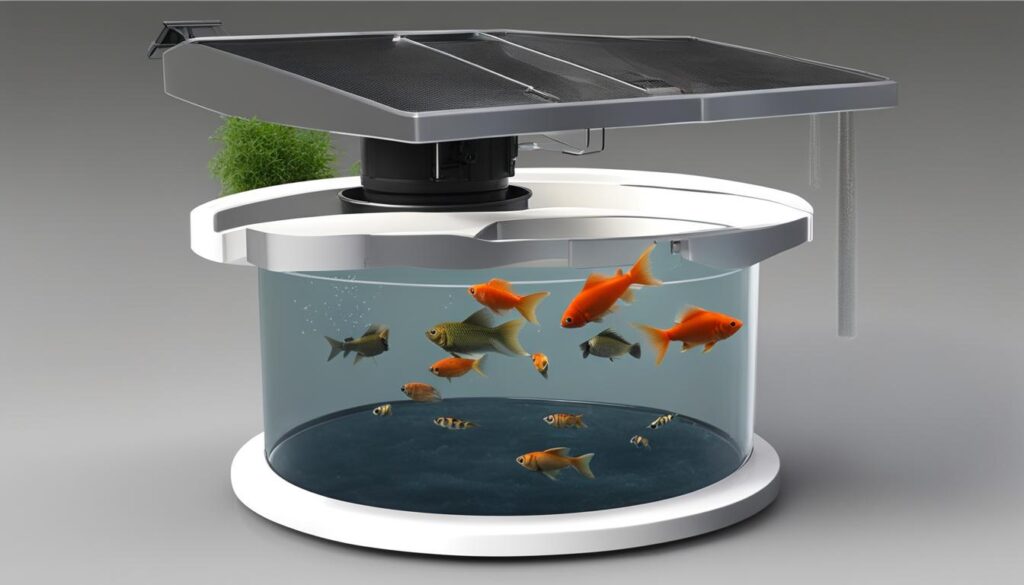
Benefits of DIY Automated Fish Feeders
Building your own automated fish feeder has its advantages. Firstly, it allows for customization to suit your specific aquarium setup and fish species. You can design the feeder to accommodate different types and quantities of food, ensuring that your fish receive the nutrition they need. Secondly, DIY automated fish feeders can be a budget-friendly alternative to commercially available options. By utilizing readily available components, you can save money while still providing a reliable feeding solution for your fish.
Considerations for DIY Automated Fish Feeders
While DIY projects can be rewarding, there are a few considerations to keep in mind. It is important to ensure that the materials used are safe for aquatic environments and do not pose any risks to the health of your fish. Additionally, DIY feeders may require more frequent maintenance and adjustments compared to commercially available options. Regular monitoring and fine-tuning of the feeder’s mechanisms may be necessary to ensure accurate and consistent feeding.
Safety Considerations for Automated Fish Feeders
When using an automated fish feeder, it is essential to prioritize the safety of your fish. Ensuring that the feeder dispenses the right amount of food is crucial to avoid overfeeding, which can lead to health issues and poor water quality. Regular monitoring of the food quality is also important to maintain the well-being of your fish. Additionally, choosing a feeder made of fish-safe materials and easy to clean is essential to prevent any contamination or bacterial growth.
“Proper feeding is essential for the health and happiness of your aquatic companions.”
During the selection process, consider feeders that have adjustable portion sizes and feeding intervals to accurately meet the dietary requirements of your fish. This will prevent overfeeding and ensure that your fish receive the right amount of nutrition. It is also recommended to research and read reviews to find feeders that have a reputation for reliability and safety.
“A well-fed fish is a happy fish!”
Regular maintenance is crucial to keep your automated fish feeder functioning properly. This includes regular cleaning of the feeder to remove any food residue or debris that may accumulate. It is also important to check and replace batteries as needed, ensuring that the feeder continues to operate reliably. Following the manufacturer’s instructions for maintenance and troubleshooting will help resolve any issues that may arise.
“Prioritizing safety and proper maintenance will ensure the longevity and effectiveness of your automated fish feeder.”
| Safety Considerations for Automated Fish Feeders |
|---|
| Ensure the feeder dispenses the right amount of food to prevent overfeeding. |
| Monitor the food quality regularly to maintain the well-being of your fish. |
| Choose a feeder made of fish-safe materials and easy to clean to prevent contamination. |
| Select feeders with adjustable portion sizes and feeding intervals to meet dietary requirements. |
| Maintain the feeder by regularly cleaning it and checking/replacing batteries as needed. |
Cost of Automated Fish Feeders
When considering an automated fish feeder for your aquarium, it’s important to take into account the cost factor. The price of automated fish feeders can vary depending on several factors such as the brand, features, and complexity of the device.
Basic models of automated fish feeders can be relatively affordable, with prices ranging from $20 to $50. These feeders usually offer simple programming options and may have limited capacity for storing food. They can be a good option for small aquariums or for those on a budget.
On the other hand, more advanced and high-end automated fish feeders can cost upwards of $100. These feeders often come with additional features such as remote control through a companion app, larger food storage capacities, and more precise feeding schedules. They may also be made with higher quality materials for durability.
| Automated Fish Feeder | Price Range | Main Features |
|---|---|---|
| Basic Model | $20 – $50 | Simple programming options Limited food storage capacity |
| Advanced Model | $100+ | Remote control through companion app Larger food storage capacity Precise feeding schedules |
When deciding on the cost of an automated fish feeder, it’s important to consider your budget and the specific features you require. It’s also worth reading reviews and comparing different brands to ensure you’re getting the best value for your money. Remember, investing in a reliable and suitable automated fish feeder can greatly enhance the care and well-being of your fish.
Pros and Cons of Automated Fish Feeders
Automated fish feeders have gained popularity among aquarium owners for their convenience and efficiency. However, like any other technology, they have their pros and cons that should be considered before making a decision. Here are some of the advantages and disadvantages of using automated fish feeders:
Pros of Automated Fish Feeders
- Convenient feeding schedules: Automated fish feeders allow for precise and consistent feeding schedules, ensuring that your fish receive the proper nutrition at the right times. You can program the feeder to dispense food multiple times per day, replicating natural feeding patterns.
- Reduced risk of overfeeding: Overfeeding can lead to poor water quality and health issues for the fish. Automated feeders dispense the right amount of food, reducing the risk of overfeeding and maintaining optimal water conditions.
- Feeding when you are away: If you travel frequently or have a busy schedule, an automated fish feeder can be a lifesaver. You can program the feeder to dispense food even when you are not available, ensuring that your fish are fed regularly.
Cons of Automated Fish Feeders
- Potential for malfunctioning: Like any electronic device, automated fish feeders can experience technical issues or malfunctions. It’s important to choose a reliable and reputable brand to minimize the risk of problems.
- Reliance on batteries or power sources: Most automated fish feeders require batteries or a power source to operate. If the batteries run out or there is a power outage, the feeder may stop working, potentially affecting your fish’s feeding schedule.
- Regular maintenance: Automated fish feeders require regular cleaning and maintenance to ensure proper functioning. Food residue can accumulate and clog the dispenser, so it’s important to clean the feeder regularly to prevent any issues.
Despite these cons, automated fish feeders can greatly enhance the fish care experience by providing precise and consistent feeding schedules. By considering the pros and cons and choosing a feeder that meets your specific needs, you can ensure the well-being of your fish and enjoy the convenience of automated feeding.
Conclusion
Automated fish feeders are a valuable fish care product that can greatly enhance the feeding experience for aquarium owners. With their precise and consistent feeding schedules, these devices provide convenience and ensure that your fish receive the proper nutrition at the right times. By reducing the risk of overfeeding, automated fish feeders also contribute to maintaining optimal water quality and the overall health of your fish.
When choosing an automated fish feeder, it is important to consider factors such as the size of your aquarium, the specific needs of your fish, and the ease of use and maintenance of the feeder. Researching popular brands like EHEIM and Rusee can help you find a reliable and suitable model for your requirements.
While automated fish feeders offer numerous benefits, it is essential to prioritize the safety of your fish. Regularly monitoring the food quality, ensuring the right amount of food is dispensed, and selecting feeders made of fish-safe materials are imperative. Additionally, following proper installation and maintenance practices will help ensure the longevity and effectiveness of your automated fish feeder.
Weighing the pros and cons of automated fish feeders is key to making an informed decision. Consider the convenience of feeding schedules and the ability to feed fish when you are away, versus potential issues like malfunctioning and reliance on batteries or power sources. With careful consideration and proper usage, automated fish feeders can be a valuable addition to any aquarium, providing improved fish care and peace of mind for aquarium owners.
FAQ
What are the benefits of using an automated fish feeder?
Using an automated fish feeder offers benefits such as precise and consistent feeding schedules, reduced risk of overfeeding, and the ability to feed fish when you are away.
What types of automated fish feeders are available?
There are various types of automated fish feeders available, including smart fish feeders, programmable fish feeders, and automatic feeding devices.
What factors should I consider when choosing an automated fish feeder?
When choosing an automated fish feeder, factors to consider include the size of your aquarium, the types of fish you have, the feeding requirements of your fish, and the ease of use and maintenance of the feeder.
How do I install and set up an automated fish feeder?
The installation and setup process for an automated fish feeder may vary depending on the specific model, but generally involves attaching the feeder to the aquarium, programming the feeding schedule, and filling the feeder with the appropriate amount of food.
How do I maintain and troubleshoot an automated fish feeder?
Regular maintenance of an automated fish feeder includes cleaning the feeder, checking and replacing batteries if necessary, and monitoring food levels. If any issues occur, refer to the manufacturer’s troubleshooting guide or contact their customer support.
What are some popular brands of automated fish feeders?
Some popular brands of automated fish feeders include EHEIM and Rusee.
Can I create my own DIY automated fish feeder?
Yes, there are options to create your own automated fish feeder using readily available components and online resources provide instructions for building custom fish feeders.
What safety considerations should I keep in mind when using an automated fish feeder?
When using an automated fish feeder, it is important to ensure that the feeder dispenses the right amount of food, monitor food quality regularly, choose a feeder made of fish-safe materials, and maintain cleanliness to prevent contamination or bacterial growth.
How much do automated fish feeders cost?
The cost of automated fish feeders can vary depending on the brand, features, and complexity of the device. Basic models can be relatively affordable, while more advanced options may come with a higher price tag.
What are the pros and cons of using an automated fish feeder?
Some pros of using an automated fish feeder include convenient feeding schedules, reduced risk of overfeeding, and the ability to feed fish when you are away. Some cons include the potential for malfunctioning, reliance on batteries or power sources, and the need for regular maintenance.



